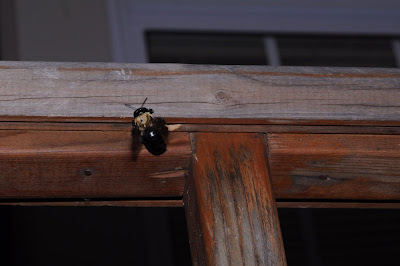So, as I was sitting there last night, waiting for my caterpillar to uncurl, I watched several large bees investigating the sides of the house. Suddenly, one came in to the porch railing where I was sitting. She flew along, apparently checking it out, and then poof! disappeared.
Uh-oh.
I looked underneath the railing, and there it was - a neat hole, about half an inch across. Carpenter bee.
As I watched, she flew back out. I sat down to wait - I wanted to get a good photo of her coming in, legs laden with pollen, so I could identify her species and determine if I had a potentially serious problem here.
On the one hand, I want to encourage our native pollinators, because a) they are native and b) honey bees are in the decline. However, on the other hand, I just spent a lot of money buying this house, and while I accept old farm houses need some work, entering a battle with carpenter bees and carpenter ants (I found about a half dozen gigantic black ants in the bathtub this morning) is not my idea of a good time.
The bee's arrivals, though, while well announced by loud buzzing when she was in-bound, did not lend themselves well to photography - she was just too fast and the camera was too slow.
Reading through my copy of Attracting Native Pollinators this morning, I think I know which bee this is, more or less. I think it is Xylocopa, the large carpenter bee (subfamily Xylocopinae). These bees can reach lengths of 1.25 inches - sure seems to fit! And, as a robust bee, it can chew its way into soft woods, excavating tunnels for laying eggs, which, apparently, are some of the largest insect eggs in the world, topping out at about a half-inch in length. Some species of Xylocopa also chew their way into flowers to get food because they are too heavy for the flower to otherwise support them while feeding.
As I sat there last night, waiting for this particular bee to return, I noticed quite a number of other individuals making forays to and from various nooks and crannies along the house. These are solitary nesters, not bees that form colonies, but if one's house is riddled with them, does that make it a colony of solitary nests? Apparently vinyl siding isn't a deterrent to these bees. Hm...looks like another research project - do I need to be concerned about the structural integrity of the house with these bees in residence (and those very suspect ants)?



We had both carpenter ants and carpenter bees at our former 100 year old house. The ants I waged war with every year, but the bees, from what I read, weren't really a threat, so I left them. At the time we left, the bees didn't seem to have caused any significant damage. That was my experience, for what it's worth.
ReplyDeleteI'm interested to see what you find in your research. I have a number of carpenter bee holes in my garage at a spot where the siding has slipped. They are pretty hefty bees!
ReplyDeleteUh oh! Here's hoping you don't have a serious problem, but rather a good opportunity to observe this little bit of wildlife.
ReplyDeleteI'm with you on the war against carpenter bees and carpenter ants!
ReplyDeleteI've a new log home and the bees love the pine boards that are the facie for my eaves and the underside of my deck rail. I, too, root for our natural pollinators but these gals have crossed the line! Why can't they stick to the many dead trees (snags) I've left on the edge of my property and leave my home alone?
As for the ants, I've seen what they can do to a pine tree and a pine board. Looks like Swiss cheese when they decide to make it home.
So far both of them (bees and ants) have left the kiln dried and stained logs alone. I'd rather like to keep it that way.